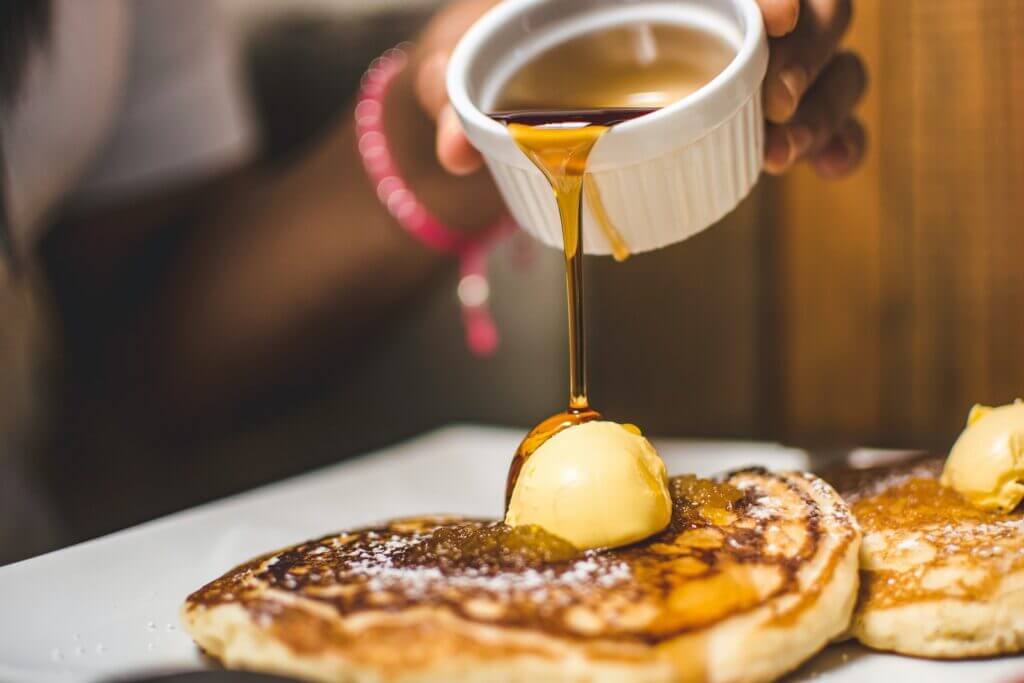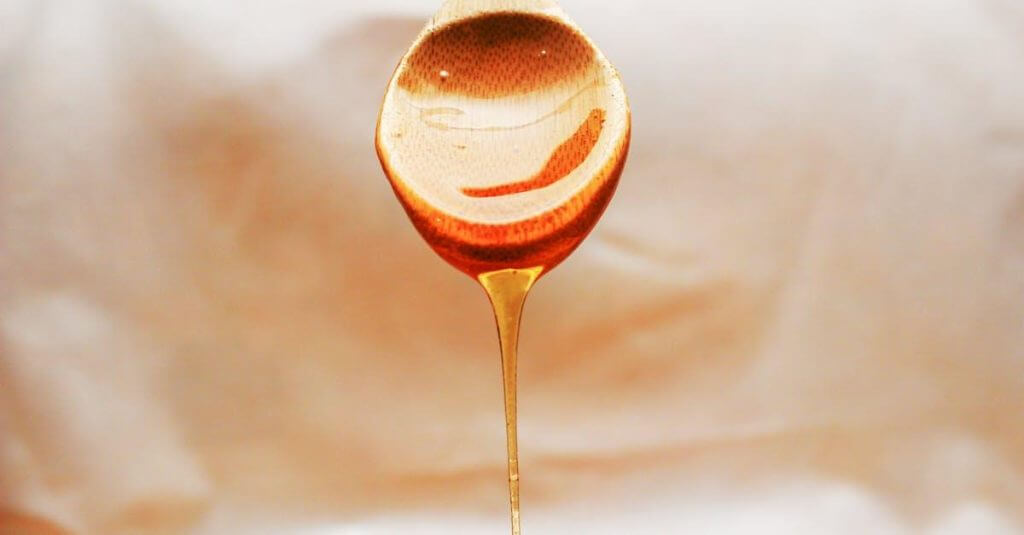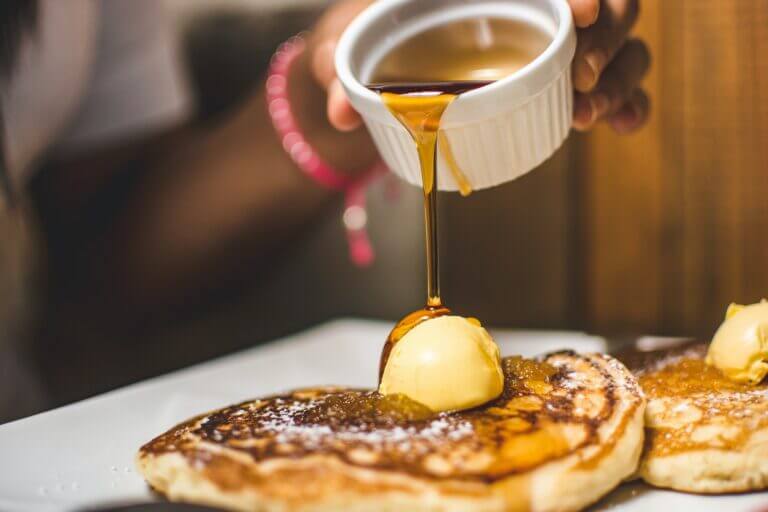Explore the production, nutrition, and health benefits of maple syrup and honey. From their grades and to culinary uses, find out which sweetener is right for you.
Maple Syrup

Production Process
Have you ever wondered how maple syrup is made? The production process of maple syrup is quite fascinating. It all starts with tapping maple trees, typically sugar maple or black maple trees, during the late winter or early spring when the sap starts to flow. A small hole is drilled into the trunk of the tree, and a spout or spile is inserted to collect the sap. The sap, which is mostly water, flows through the spout into a bucket or tubing system.
Once the sap is collected, it undergoes a series of steps to transform it into delicious maple syrup. The sap is first filtered to remove any impurities, such as twigs or debris. Then, it is transferred to large evaporator pans where it is heated over a fire or using modern equipment. As the sap heats up, the water content evaporates, leaving behind a concentrated liquid known as maple syrup.
The final step in the production process is filtering the syrup again to ensure its clarity and remove any remaining sediment. It is then hot-packed into containers, such as bottles or cans, ready to be enjoyed on pancakes, waffles, or in various recipes.
Grades and Classification
Maple syrup is classified into different grades based on its color and flavor. The grading system varies slightly depending on the region, but the most common grading system used in the United States and Canada includes four grades: Golden, Amber, Dark, and Very Dark.
- Golden: This grade of maple syrup has a light color and a delicate, mild flavor. It is often preferred for its subtle sweetness and is commonly used as a topping for pancakes and desserts.
- Amber: Amber maple syrup has a slightly darker color and a more pronounced flavor compared to Golden syrup. It offers a balanced combination of sweetness and maple flavor, making it versatile for both sweet and savory dishes.
- Dark: As the name suggests, Dark maple syrup has a richer, deeper color and a stronger flavor profile. It is often used in recipes that require a more intense maple taste, such as glazes and marinades.
- Very Dark: This grade of maple syrup has the darkest color and the strongest flavor. It is typically used in cooking or baking, where the robust maple flavor can shine through.
Each grade of maple syrup has its own unique characteristics, allowing individuals to choose the one that best suits their taste preferences and culinary needs.
Nutritional Value
Maple syrup not only adds a delicious touch to your meals but also offers some nutritional benefits. While it is important to consume maple syrup in moderation due to its sugar content, it does contain some essential nutrients.
One tablespoon (20 grams) of maple syrup provides approximately:
- Calories: 52
- Carbohydrates: 13 grams
- Calcium: 2% of the Daily Value (DV)
- Potassium: 1% of the DV
- Iron: 1% of the DV
- Zinc: 1% of the DV
- Manganese: 33% of the DV
Maple syrup is also a source of antioxidants, which help protect the body against oxidative stress and inflammation. It contains various phenolic compounds, including gallic acid and catechins, that contribute to its antioxidant properties.
It is worth noting that the nutritional content may vary slightly depending on the grade of maple syrup. Darker syrups tend to have higher mineral content compared to lighter ones. Nonetheless, maple syrup should be enjoyed as part of a balanced diet, considering its sugar content.
Health Benefits
In addition to its delightful taste, maple syrup offers some potential health benefits when consumed in moderation.
- Antioxidant Support: As mentioned earlier, maple syrup contains antioxidants that can help protect the body against free radicals and reduce oxidative stress.
- Anti-Inflammatory Properties: Some studies have suggested that certain compounds found in maple syrup, such as quebecol and ginnalin A, possess anti-inflammatory properties. These compounds may help alleviate inflammation in the body.
- Natural Sweetener: Maple syrup can be a healthier alternative to refined sugar or artificial sweeteners. It adds sweetness to your dishes while providing some essential nutrients.
- Energy Boost: Maple syrup is a source of carbohydrates, which are essential for providing energy to the body. It can be a natural and tasty option for fueling your daily activities.
However, it is important to remember that maple syrup is still a sweetener and should be consumed in moderation. Excessive intake of added sugars, including maple syrup, can contribute to weight gain and other health issues.
Culinary Uses
Maple syrup is a versatile ingredient that can be used in a wide range of culinary creations. Its unique flavor adds a delightful touch to both sweet and savory dishes. Here are some popular for maple syrup:
- Pancake and Waffle Topping: Maple syrup is a classic topping for pancakes and waffles. Its sweet, distinctive flavor pairs perfectly with the fluffy texture of these breakfast favorites.
- Salad Dressing: Create a homemade salad dressing by combining maple syrup, olive oil, vinegar, and your favorite herbs and spices. The natural sweetness of maple syrup adds a pleasant contrast to the acidity of the dressing.
- Glazes and Marinades: Maple syrup can be used to create delicious glazes for roasted meats, such as ham or chicken. It adds a caramelized sweetness and imparts a beautiful glossy finish. It can also be incorporated into marinades for a touch of sweetness and flavor.
- Baking: Maple syrup can be a wonderful substitute for other liquid sweeteners, such as honey or molasses, in baking recipes. It adds moisture, flavor, and natural sweetness to cakes, cookies, muffins, and more.
- Drinks: Maple syrup can be used to sweeten and flavor various beverages, including coffee, tea, smoothies, and cocktails. Mix it with warm milk for a comforting and indulgent maple latte.
Remember to get creative and explore the many possibilities that maple syrup offers in the kitchen. Its distinct flavor can elevate your dishes and add a touch of sweetness in a natural and delightful way.
Honey

Honey is a natural sweetener that has been used for centuries in various cultures around the world. It is not only delicious but also boasts a range of . In this section, we will explore the different types of honey, the process of harvesting and extraction, the composition and nutritional content, the medicinal properties, and the of this golden syrup.
Types of Honey
Honey comes in various types, each with its unique flavor profile and characteristics. Let’s take a closer look at some of the most popular types of honey:
- Wildflower honey: This type of honey is produced from nectar collected by bees from a variety of wildflowers. It has a rich, floral flavor and can vary in color depending on the predominant flowers in the area.
- Clover honey: Clover honey is made from the nectar of clover plants. It has a mild, sweet taste and a light color. Clover honey is widely available and is often used as a versatile sweetener.
- Manuka honey: Manuka honey is native to New Zealand and is highly regarded for its potent antibacterial properties. It is derived from the nectar of the Manuka tree and has a distinctive, robust flavor.
- Acacia honey: Acacia honey is known for its light, delicate taste and pale color. It is sourced from the nectar of the acacia tree and is prized for its high fructose content, making it slow to crystallize.
- Buckwheat honey: Buckwheat honey has a strong, robust flavor and a dark color. It is derived from the nectar of the buckwheat plant and is often sought after for its unique taste and potential antioxidant properties.
Harvesting and Extraction
The process of harvesting and extracting honey is a labor-intensive yet fascinating endeavor. Beekeepers carefully collect honey from beehives using specialized equipment. Here’s an overview of the process:
- Beehive inspection: Beekeepers regularly inspect the beehives to assess the honey production and overall health of the colony. This helps them determine the optimal time for extraction.
- Removing honey supers: Honey supers are boxes placed on top of the beehive where bees store excess . Beekeepers carefully remove these supers without disturbing the bees.
- Uncapping the honey: Once the supers are removed, beekeepers use a hot knife or uncapping fork to remove the wax cappings that seal the honeycomb cells. This exposes the honey for extraction.
- Extracting the honey: The uncapped frames are then placed in a honey extractor, which uses centrifugal force to spin the frames and extract the honey. The extracted honey is collected in a container.
- Straining and filtering: To remove any impurities or debris, the extracted honey is strained and filtered. This ensures a smooth and pure final product.
- Bottling and packaging: The filtered honey is now ready for bottling and packaging. It is poured into jars or bottles, sealed, and labeled for sale or personal use.
Composition and Nutritional Content
Honey is not just a sweet treat; it also contains a variety of beneficial compounds. Here is an overview of the composition and nutritional content of honey:
- Carbohydrates: Honey primarily consists of carbohydrates, mainly in the form of fructose and glucose. These natural sugars provide a quick source of energy.
- Antioxidants: Honey contains various antioxidants, including phenolic compounds, which can help protect the body against oxidative stress and reduce the risk of chronic diseases.
- Vitamins and minerals: While the exact composition may vary depending on the type of honey, it generally contains small amounts of vitamins and minerals such as vitamin C, calcium, and potassium.
- Enzymes: Honey contains enzymes that contribute to its antimicrobial properties and aid in the digestion of carbohydrates.
- Water content: Honey has a relatively low water content, typically ranging from 17% to 20%. This low moisture content helps prevent the growth of bacteria and yeast.
Medicinal Properties
Throughout history, honey has been revered for its medicinal properties. Here are some of the potential associated with consuming honey:
- Soothes cough and sore throat: Honey has long been used as a natural remedy for cough and sore throat. Its viscous texture helps coat the throat, providing relief and soothing irritation.
- Boosts immune system: The antioxidants and antibacterial properties of honey can help support a healthy immune system, reducing the risk of infections and promoting overall well-being.
- Wound healing: Honey’s antimicrobial properties make it an effective topical treatment for wounds and burns. It can help prevent infection, reduce inflammation, and promote faster healing.
- Aids digestion: The enzymes present in honey can aid in the digestion of carbohydrates, making it beneficial for individuals with digestive issues.
- Allergy relief: Some people believe that consuming locally sourced honey can help alleviate seasonal allergies. The theory is that exposure to small amounts of local pollen in honey may desensitize the body to allergens over time.
Culinary Uses
Honey is not only a natural sweetener but also a versatile ingredient in the culinary world. Here are some creative ways to incorporate honey into your recipes:
- Sweetener: Honey can be used as a healthier alternative to refined sugar in various dishes and beverages. Its unique flavor profile adds depth and complexity to sweet treats like cakes, cookies, and smoothies.
- Marinades and glazes: The natural sugars in honey make it an excellent ingredient for marinades and glazes. It adds a hint of sweetness and helps caramelize the surface of meats and vegetables.
- Salad dressings: Honey can be used to balance the flavors in salad dressings. Its sweetness pairs well with acidic ingredients like vinegar or citrus, creating a harmonious blend of flavors.
- Baking: Honey can act as a natural humectant, keeping baked goods moist and tender. It can be used in bread, muffins, and other baked treats to enhance both flavor and texture.
- Cheese pairing: Honey’s sweetness and viscosity make it a delightful accompaniment to various types of cheese. Try drizzling honey over a cheese platter or pairing it with a tangy blue cheese for a truly tantalizing experience.
In conclusion, honey is a versatile natural sweetener with a range of flavors, health benefits, and culinary uses. Whether you’re enjoying it in your tea, using it as an ingredient in your favorite recipes, or exploring its potential medicinal properties, honey continues to captivate us with its golden goodness. So go ahead, indulge in the sweetness of nature’s golden gift!





